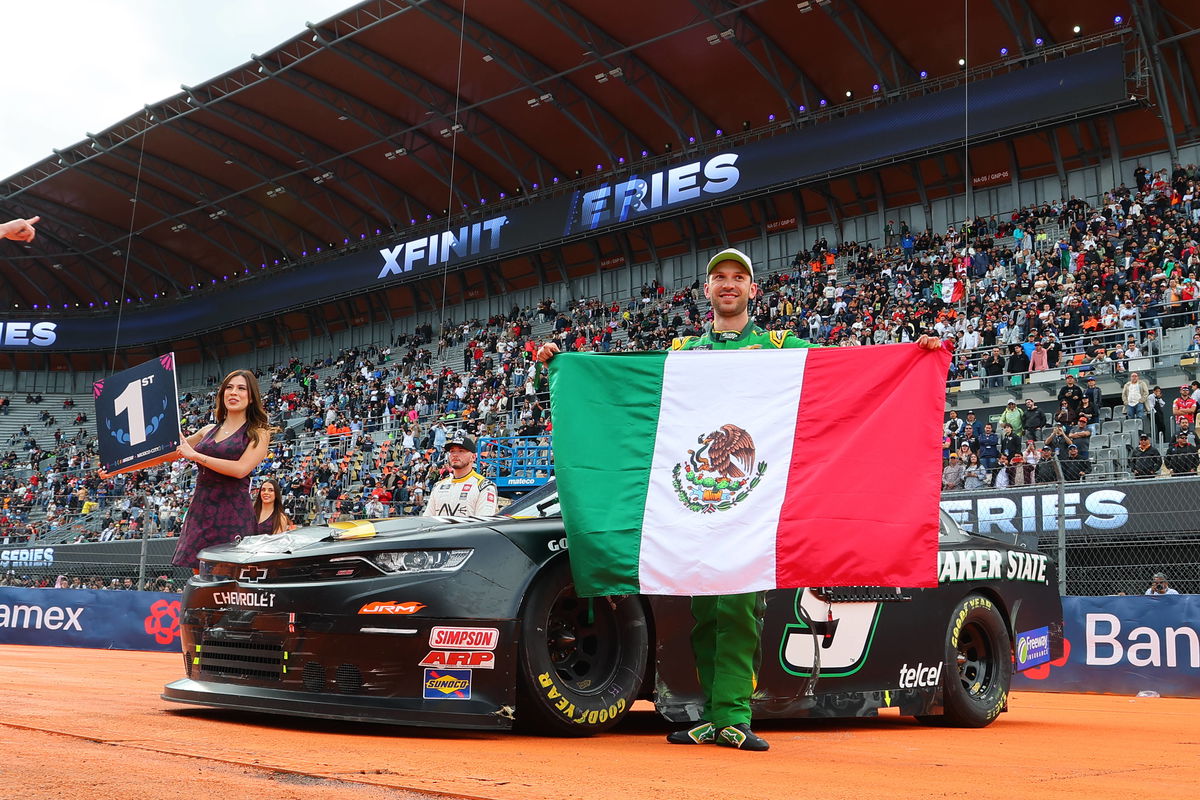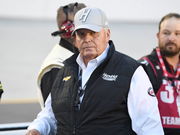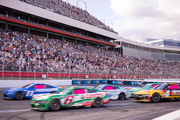
Imago
June 14, 2025, Mexico City, Iztacalco, 08400 Ciudad De Mo Xi, USA: DANIEL SUAREZ 9 of Monterrey, Mexico MEX wins the The Chilango 150 in Mexico City, Iztacalco, 08400 Ciudad de Mo xico, CDMX, Mexico. Mexico City USA – ZUMAa161 20250614_aaa_a161_067 Copyright: xWalterxG.xArcexSr.x

Imago
June 14, 2025, Mexico City, Iztacalco, 08400 Ciudad De Mo Xi, USA: DANIEL SUAREZ 9 of Monterrey, Mexico MEX wins the The Chilango 150 in Mexico City, Iztacalco, 08400 Ciudad de Mo xico, CDMX, Mexico. Mexico City USA – ZUMAa161 20250614_aaa_a161_067 Copyright: xWalterxG.xArcexSr.x
It’s no secret that NASCAR has its sights set on international expansion. For years, the sport has looked beyond its traditional oval tracks, with the 2023 Chicago Street Race marking the start of a new era. Running stock cars through Michigan Avenue and Lake Shore Drive wasn’t a one-off gimmick either; it earned the ‘Sports Event of the Year’ at the 2024 Sports Business Awards. But then came the Mexico City race.
Watch What’s Trending Now!
For the first time since 1958, a points-paying Cup Series fixture was held outside the United States. The Viva Mexico 250 even outperformed Formula 1 and IndyCar in TV ratings that weekend, with Daniel Suárez calling it a breakthrough moment: “That’s what we need.” Yet, beneath the surface, challenges quickly emerged.
ADVERTISEMENT
NASCAR’s Mexico outing wasn’t all good after all
To start with, the logistics were a nightmare, and while Ryan Blaney enjoyed the experience south of the border, he couldn’t help but say, “I would like to see maybe it’s a week off after an international event, just to give everybody a little bit of a breather.”
The event proved NASCAR’s ambition but also exposed how far the series still has to go in infrastructure and planning. Compared to Formula 1, NASCAR’s global readiness felt decades behind.
But here’s the key;
ADVERTISEMENT
- F1 didn’t become a global powerhouse overnight. It carefully engineered its expansion, from Netflix’s Drive to Survive to a calendar spanning five continents.
- It built an aspirational image rooted in cutting-edge technology. NASCAR, meanwhile, remains tied to ovals, V8 engines, and sponsors with a U.S.-first focus.
That’s not inherently bad. NASCAR’s Southern heritage is its strength, keeping the sport financially healthy and culturally authentic. But if it wants global respect, it can’t just play catch-up with F1’s playbook. It needs to fix its own fundamentals first.
ADVERTISEMENT
We know, for years, NASCAR has relied on these pillars:
- Its roots and oval racing, a style that doesn’t always appeal to international audiences. However, the younger motorsports fans from around the world want sustainable technology and a variety of racing formats.
- The sport has been slow to adopt hybrids and electric vehicles, despite having more road course races on the calendar than ever before
- Relying on custom-built naturally aspirated V8 engines instead. And even though stock car fans love the roar from the Next-Gen cars, the decision has set the sport behind the curve.
Meanwhile, younger motorsports fans want sustainability, digital access, and variety in formats. That doesn’t mean NASCAR should abandon its identity. There has to be a strategy in place. To start with, NASCAR needs its drivers to be on the same page. Brad Keselowski in 2023 had some bold comments to make when asked to comment on F1’s growing global presence.
ADVERTISEMENT
“Generational preferences come and go. I don’t see NASCAR falling by the wayside, I see it is a constant rollercoaster of ups and downs. What’s key is for our sport to stay true to itself, not lose its fundamentals.” While Keselowski talked and supported what makes NASCAR great, maybe one shouldn’t look down upon the generational preferences, as NASCAR needs that younger fanbase like F1. At the same time, Keselowski too had a point as he was talking on behalf of the core fans that made the sport great.
Top Stories
Rick Hendrick Strikes Fear in NASCAR Fans With Chevy’s New “Illegal” Car

New Charter Deal Triggers ‘Financial Frenzy’ as NASCAR Teams Set for Massive Payday

Martin Truex Jr’s Former Crew Chief Ends 12-Year Fight In Huge Personal Announcement

Denny Hamlin Gloats as Jim France Forced to Eat His Words Against Rick Hendrick & Co.

Dale Jr. Reveals How Permanent Charters Could Turn NASCAR Into a Billionaire’s Club With a Brutal Reality Check

It’s about serving the underserved!
If we look at the recent business deals within the sport, there’s a sentiment around NASCAR not putting effort into building streaming avenues for fans outside the United States. Now, this seems counterproductive, especially considering their plans for international expansion. Meanwhile, when we look at Formula 1, MotoGP, and the World Endurance Championship have all embraced technological innovation and global outreach.
ADVERTISEMENT
NASCAR, when compared to all the above motorsports, somewhat comes across as a bit dated, especially at a time when fans are looking for sustainability, technology, diverse representation, and digital access. And that is the kind of change that will help NASCAR gain a younger audience, not just outside the US, but also inside the US.
Backing this up was Joey Logano in 2024, when he said, “I think staying open-minded to those things is so important not only as a competitor but as a race fan um that we need to be open-minded about changing things and doing different things, whether it’s a fan the drivers the teams NASCAR themselves have to be open to making changes too. At the same time, we want to stay true to our roots; what makes NASCAR ‘NASCAR’ — full contact heavy, hard racing. That’s what we are, the Grassroots racing; we don’t want to lose that either.” And, you wouldn’t agree more.
ADVERTISEMENT
What’s next for NASCAR?
Firstly, maybe it’s high time they need to commit to one thing; either go all international and put a stop to it. And, as per reports, the sports body is already on the move. Earlier this year, Adam Stern hinted that ‘The Clash’ could potentially be held in Brazil in the foreseeable future, a step in the right direction for the stock car racing series.
Secondly, NASCAR’s ABB integration for hybrid or EV should come into play now, more than ever. And, they should be on the same page as manufacturers who want their racing programs to align with their showroom products.
Lastly, it’s the driver pool. Maybe NASCAR needs to attract more globally recognized motorsports stars to compete in the Cup Series, which would not only improve the competition but also show the world that the stock car racing series isn’t just an American sport.
ADVERTISEMENT
It’s a discipline that reflects diversity from across the world. Sure, the inclusion of Shane van Gisbergen and Katherine Legge is a step in the right direction, but promoting rising talent like the Truck Series’ Andrés Pérez de Lara and NASCAR Euro Series driver Thomas Krasonis can go a long way.
The sport also needs to explore creative solutions to age-old problems. The Chicago Street race or the upcoming San Diego Naval Base event in 2026 is what fans globally want to see more of.
Such initiatives keep the fast-paced NASCAR sentiment alive, attract positive attention, and prove that the US’s greatest sport can adapt when it wants to, busting longstanding myths.
ADVERTISEMENT
The bottom line is that NASCAR doesn’t need to lose its American identity to earn global respect. Relying on its Southern heritage will always be the sports’ strength, as long as it’s paired with innovation and a clear vision for the future.
Fans worldwide are hungry for stock car racing to expand, and sponsors are eager to show their support. While the logistics are challenging, they are solvable; however, NASCAR needs to adopt a more proactive approach.
ADVERTISEMENT
ADVERTISEMENT
ADVERTISEMENT

